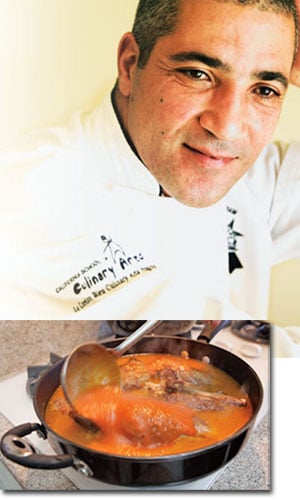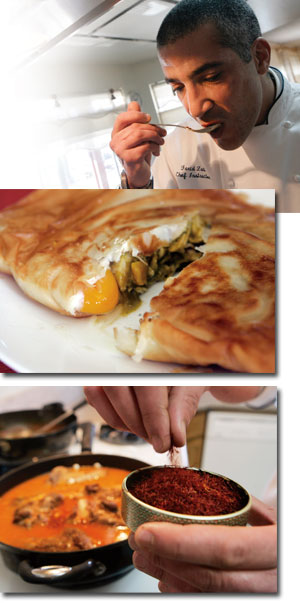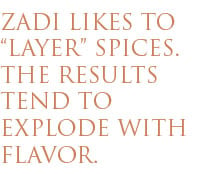Written by
Charles Perry
Photographed by Béatrice de Géa
 |
| Centerpiece of North African cooking is the spice-rich stew known as tagine. Algerian tagines are often earthier than Moroccan ones, and they frequently feature tomato-based sauces, harissa and fennel. |
 arid Zadi is finishing off a tagine of lamb shanks braised with nuts and apricots in spicy tomato sauce, the crown of a meal that includes four Algerian salads and the flaky filo snacks called breek. As he skims the fat from the tagine’s red-orange surface, he slyly says, “This is the French chef in me. In Algeria, they probably wouldn’t skim it.”
arid Zadi is finishing off a tagine of lamb shanks braised with nuts and apricots in spicy tomato sauce, the crown of a meal that includes four Algerian salads and the flaky filo snacks called breek. As he skims the fat from the tagine’s red-orange surface, he slyly says, “This is the French chef in me. In Algeria, they probably wouldn’t skim it.”
Born in France of Algerian Berber ancestry, married to an American woman born in Korea, with cooking experience in five countries, Zadi, 39, has the sort of cosmopolitan perspective that probably represents the future of cuisine. He’s knowledgeable about North African food as well as classical French cookery.
His bully pulpit isn’t a restaurant but a Le Cordon Bleu course at the California School of Culinary Arts in Pasadena, where he’s training many of the upcoming generation of chefs. They’re basically learning French technique, but Zadi makes sure they know the right way to make a couscous as well.
He’s making his influence felt through his writing and food blogging too, and he champions North African cuisine as a board member of the new Pan-Arab division of Slow Food International, the nonprofit organization dedicated to preserving traditional cuisines.
“I first learned of him by reading his defense of Algerian food on eGullet.com,” says food writer Paula Wolfert. “It was very touching—so smart, so passionate, so directed toward what quite a few of us are interested in.”
Training and passion are fine things, but the proof is in the tagine. The fact is, Zadi is a brilliant chef. Everything he touches explodes with fragrance.
North African food—perhaps the last underappreciated Mediterranean cuisine—has been slipping more and more into the mainstream in the United States—particularly during the last year in Southern California. More and more restaurants now find room on their menus for a couscous, and other North African elements are showing up too: merguez lamb sausage, bisteella (chicken in flaky pastry with spices and sugar) and harissa hot sauce.
And this is Zadi’s bailiwick. On the one hand, he’s cooked at the famous two-star Restaurant Jacques Cagna in Paris. On the other, he spent part of his youth in Sétif, his family’s hometown in the Kabylie region of northeastern Algeria, where he herded sheep in upland pastures.
So he’s both a cosmopolitan and a homeboy. “When I went to Oran [in western Algeria], they told me I’m more French than Algerian,” he recalls with a pitying look. “I told them, ‘I’m more country than any of you.’”
Right now he’s demonstrating some of his dishes: the tagine; a carrot-fennel salad; a blood-orange, fennel and onion salad; a roast-chicken breek; various condiments; and, for dessert, a sweet, nut-filled pastry with blood-orange sauce. What is Algerian food? Zadi has been writing a book that will address its history, but he’s reluctant to draw any sharp lines dividing Algerian, Moroccan and Tunisian cuisines. They all have a lot in common, such as the spice-rich stews called tagines and specific ingredients such as couscous, preserved lemons and a local flaky pastry somewhat similar to filo.
Still, he points out, Algeria does have a focus of its own. It’s known for its use of tomato sauces and harissa. Americans would be struck by how often Algerian cooks flavor dishes with one part or another of the fennel plant—seed, bulb or fronds. (A salad may consist of olives dressed with fennel purée.) Altogether, Algerians eat a lot of salads, particularly of mixed wild greens.
By comparison with Moroccan cuisine, which is colored by the aristocratic traditions of its royal cities, Algerian food tends to be simple and earthy. What’s the recipe for the famous Algerian spice mixture ras al-hanout? “It’s just all the spices you have on hand,” says Zadi—but freshly ground. (He even grinds his own turmeric root.) Over and over, in demonstrating his recipes, he emphasizes that ingredients can be substituted according to availability or desire.
Not that simplicity means predictability. On his Web site, Zadi gives a recipe for an elegantly simple couscous flavored with lavender flowers.
Zadi likes to “layer” spices—add them at different stages of cooking. For his tagine, he rubs the lamb shanks with olive oil and ras al-hanout before frying them in extra-virgin olive oil. (He says Algerian olive oil, not available in this country, is much darker in color than Italian extra-virgin, jesting, “You could put it in your car and drive for a week.”)
 |
| Breek is Algerian flaky pastry wrapped around fillings—the classic is egg, but Zadi has made breeks with Korean kimchi and, above, chicken with chermoula and egg yolk |
When the lamb is browned, he fries garlic and onions with a little ras al-hanout. Then he adds the onions to the shanks along with homemade tomato sauce and more ras al-hanout. After simmering the shanks with ground nuts, winter squash and turnips, he adds some fresh harissa for heat and maybe a little saffron for fragrance. Then everything cooks with apricots, raisins and honey.

Together with the inevitable salt and pepper at the very end, that makes five stages at which spices are added. The result is rich and fragrant but harmonious, with no one ingredient dominating.
The fresh harissa that Zadi adds to the tagine turns out to be quite simple to make, just a matter of puréeing several kinds of peppers with garlic, olive oil and sun-dried tomatoes, a traditional ingredient in North Africa. (“The food processor is your friend,” says Zadi, in a cooking-teacher mood.)
The result tastes something like a concentrated salsa with a combination of fresh and dried chile flavors, and goes with a wide variety of foods: stews, roasts, fried dishes, salads, anywhere a flavorful hot sauce would be welcome.
Another versatile Algerian sauce is chermoula, a lemony vinaigrette puréed with garlic, chiles and a mixture of flat-leaf parsley and cilantro. It is used as a marinade or a dipping sauce, particularly with fried fish. Zadi goes very easy on the cilantro, because he believes it should be used subtly. (“I’m very opinionated,” he explains. “That’s why I’m Algerian.”)
While the tagine cooks, Zadi assembles an array of salads. A pastel-colored mixture of shredded carrot and fennel bulb is dressed with vinaigrette and garnished with toasted pine nuts. A bowl of green olives becomes a salad when presented with three toppings: chermoula, harissa and puréed fennel.
A mixture of roasted peppers, shredded fennel and chopped tomatoes, the kind of dish often presented to guests in Algeria along with flatbread, comes with no dressing at all: humble, earthy and fresh.
The grandest of the salads is made with sliced blood orange, shredded fennel and paper-thin slices of onion, dressed with orange juice, olive oil and parsley. “Put it in the fridge for half an hour,” he says. “The acidity of the orange cooks the onion.” He serves this on mixed greens.
His way of making Algerian food reflects his classical training at the Ecole Hôtelière d’Eragny in Paris. For instance, he cuts up the vegetables for his tagine smaller than a home cook would and adds them later in the cooking to achieve a fresher flavor. The layering of spices is his way of achieving the effect of daylong or overnight cooking in a clay pot, and he doesn’t disdain European utensils such as the mandoline and the food processor. “I like to encourage people to cook,” he says, “rather than discourage them by nagging about ‘old methods.’” And he compromises when making breek. In North Africa, the local pastry called warka or malsouka would be used, but it’s not available here, so Zadi substitutes filo, though grumbling a little at its relative fragility and tendency to dry out as you’re working with it.
The classic breek is breek à l’oeuf, simply a sheet or two of malsouka (or filo) folded around a raw egg and fried crisp and brown in plenty of olive oil.
But you can put other things in the filling along with the egg. Zadi improvises a very tasty one with leftover roast chicken and chermoula. “In Algeria,” Zadi says, “people have breek parties—they put out all sorts of fillings and let people make their own.” He’s made breeks with tuna and Korean kimchi.
Except at Ramadan, Algerians don’t eat sweet pastries with their meals, which typically end with fruits and nuts. Pastries go with coffee or tea.
Among the common ones is samsa, made by folding a two-inch-wide strip of filo around a ground-almond filling in a triangular shape, then frying. A cousin of baklava formed this way (though baked, rather than fried) was popular in this country during the filo craze of the 1970’s, but Americans tended to get tired of it because the filling was so relentlessly sweet. Like many Algerians today, Zadi cuts down on the sugar.
When making old-time Algerian home-style sweets, he follows the traditional techniques, but with a pastry such as samsa, which Algerians consider an international recipe, he may innovate in a way that reflects his French culinary training.
To accompany samsa, he makes a more interesting sauce than the honey or sugar syrups that usually accompany baklavas: a tangy orange syrup (using both juice and peel), which has a particularly memorable rose hue when made with blood oranges.
Besides teaching, running two Web sites and helping start the new branch of Slow Food, Zadi is planning a pan-Mediterranean food festival in Los Angeles for 2008 and talking with a television producer about a food-history program.
And there’s that book. Along with its discussion of Algerian food history, he intends it to “teach cooking techniques and encourage creativity. Simplify recipes and cooking.”
But once in a while he takes a break and goes back to relax with the family in Sétif. “What I do when I’m in Algeria,” he says, “is eat, laugh and drink coffee with my friends.”
 |
Charles Perry (charles.perry@latimes.com) studied at Princeton University, the University of California and Shimlan, Lebanon. Today a food writer for The Los Angeles Times, he has written widely on food history and recently published a fresh translation of al-Baghdadi’s 13th-century cookbook (A Baghdad Cookery Book, Prospect Books, 2005). |
 |
Like Farid Zadi, photojournalist Béatrice de Géa (beatrice.degea@gmail.com) was born in France of North African heritage. She was a staff photographer at The Los Angeles Times for seven years, and now works as a free-lancer for The New York Times. |